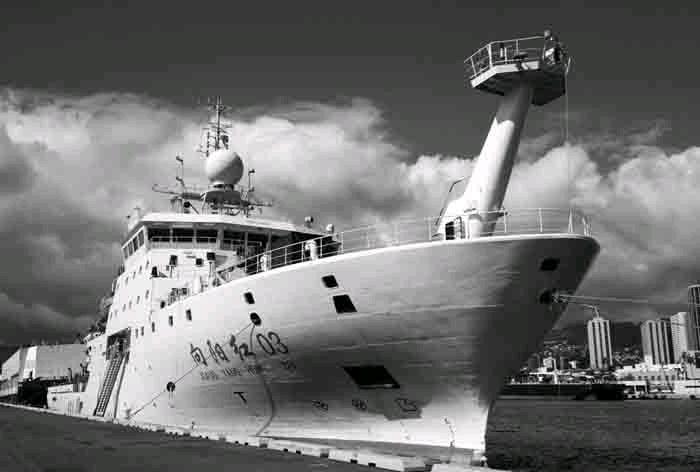China Leads in Shipbuilding
Orders for Chinas re- bounding shipbuilding industry reached the top place in the world in the past 11 months, surpassing its counterpart South Korea, according to an international industrial analysis agency.
According to the data released by British shipbuilding and marine analysis agency Clarkson Research Services on Friday, from January to November, Chinas shipbuilding order volume totaled 7.13 million compensated gross tons from 324 vessels, followed by South Korea, which has received 5.74 CGT.It is the first time in the past seven years China has exceeded South Korea in shipbuilding orders. The data also show that Chinas shipbuilding industry secured 36.3 percent of the global market, 7 percentage points more than South Korea, which accounts for 29.4 percent of global orders.
This August, French group CMACGM SA ordered nine 22,000 twentyfoot equivalent units container vessels from Shanghai Waigaoqiao Shipbuilding Co and Hudong Zhonghua Shipbuilding Co. In October, China State Shipbuilding Corp, China Investment Corp and Carnival Corp, the worlds biggest cruise operator, signed an agreement to invest total 25.5 billion yuan ($3.85 billion) to build a super luxury cruise ship. It was also the first order of this kind Chinese shipbuilding companies had ever received.
Dong Liwan, a shipbuilding industry researcher at Shanghai Maritime University, said with the orders for high-value-added ships continuing to go to Chinese shipyards, their South Korean competitors will definitely feel the pinch. Chinas shipbuilding business is also moving from quantity to quality, as the industry is becoming more intelligent and environmentally friendly. “Chinas shipbuilding industry is realizing the transformation with its hardworking spirit to achieve technical breakthrough and innovation,” said Sun Licheng, president of China Classification Society. “While maintaining growth, it is realizing production mode transformation, structural adjustment and transformation, and upgrading, and reinforcing Chinas shipbuilding status in the world.” Sun said the goal is to become a strong shipbuilding country by 2020, and to accelerate the development of advanced intelligent manufacturing and industrial equipment capability.
At the recent All China Maritime Conference and Exhibition, China State Shipbuilding Corporation has delivered the worlds first smart ship, Great Intelligence, with a loading capacity of 38,800 metric tons. Meanwhile, COSCO Dalian shipyard has signed orders with Thordon Bearings, a marine industry solution provider for its water lubricated propeller shaft bearings, which can use seawater as the lubrication medium instead of oil that could cause pollution. Alex Li, managing director of CY Engineering Co Ltd, Thordon Bearingspartner in China, said that the latest order is a significant sign showing Chinese shipbuilders commitment to reducing industry-borne emissions and pollutants.
Chinas shipbuilding sector experienced a strong momentum in the first three quarters of this year with growth in both completed orders and new orders, according to data released by the China Association of the National Shipbuilding Industry. Chinese shipyards executed orders amounting to 35.15 million dead weight metric tons in the first nine months, up 41 percent year-on-year, while they received 20.13 million DWT of new ship orders, an 8.7 percent increase from the same period a year earlier, statistics from Beijing-based CANSI show.
Total revenue of Chinas shipbuilding industry reached 212.5 billion yuan($32 billion), with net profit totaling 1.1 billion yuan during the January-September period. The Baltic Dry Index, a barometer of global bulk shipping business climbed to 1,566 points on Oct 18, a new high since March 2014. Since August this year, BDI, which measures the shipping fees of dry cargo such as iron ore, cement, grain and coal, has stayed above the 1,000-point threshold, indicating strong demand for raw materials and therefore more need for shipping services.
Large demand for dry cargo like iron ore boosted the development of the bulk cargo ship sector, whose orders plummeted from 1,953 in 2007 to 55 in 2016, with capacity decreasing by 91 percent. Dalian COSCO KHI Ship Engineering Co Ltd, a joint venture between China COSCO Shipping Co Ltd and Japans Kawasaki Heavy Industries,received two Ultramax bulk cargo ship orders from Singapore-based Eastern Pacific Shipping Pte Ltd. Weighing 61,000 DWT each, it is the shipyards first new order since the end of 2015, which is expected to be delivered in 2019.
Dong Liwan, a shipbuilding industry professor at Shanghai Maritime University, expects less fierce competition in the industry, as small shipping companies were forced out of the game both at home and in overseas markets. “The tonnage would have seen steady growth had there been further industrial consolidation,” said Dong. “This will exert further downward pressure on freight rates for the whole industry.” ICBC Financial Leasing Co Ltd, the subsidiary of Industrial and Commercial Bank of China, and China Merchants Energy Shipping Co will order six and possibly another three very large ore carriers respectively with 325,000 of DWT each from Qingdao Beihai Shipbuilding Heavy Industry Co at a total value of$675 million, TradeWinds reported.
In August, Shanghai Waigaoqiao Shipbuilding Co and Hudong- Zhonghua Shipbuilding (Group) Co, two Shanghai-based shipyards, together received a letter of intent from French group CMACGM SA for nine vessels capable of transporting 22,000 twentyfoot-equivalent-unit containers-the largest carrying capacity in the world. However, CANSI warned the industrys economic performance has worsened during the January-September period. The gross industrial output value of the 80 major companies in the shipping in- dustry amounted to 284.35 billion yuan during the first nine months of this year, down 6.9 percent from the same period a year ago.
“Chinese shipyards have long been famous for their ability to quickly and cheaply churn out large numbers of simple vessels,” said Zhang Hui, an industry analyst with Donghai Securities Co Ltd.
“The trouble is that an oversupply remains of exactly these sorts of ships, even while the demand has increased for more complex craft: megacontainers-large vessels capable of carrying vast amounts of cargo-ships that run on liquefied natural gas and drilling vessels.”
Dalian Shipbuilding Industry Company (DSIC), one of the largest shipbuilding companies in the country, is charting a new course to overcome decline in global demand. Based in Dalian in Northeast Chinas Liaoning province, the State-owned company is shifting its focus away from conventional shipbuilding to high-end vessels such as very-large crude and ore carriers and bulk carriers. The shipping giant, which has 12,000 employees, recorded revenue of 23.4 billion yuan ($ 3.4 billion) in 2016 and net profit of 760 million.
DSICs service spans the entire life cycle of a ship, including research and development, construction, repair and scraping. Its the only domestic equipment manufacturing enterprise that has expertise in all five industrial sectors: military project undertaking, shipbuilding, offshore equipment building, ship repair/ship scraping and heavy industrial project undertaking.
As the flagship of Chinas shipbuilding industry, DSIC has made great contribution to national defense and modernization of navy.
More than 800 naval ships of 44 types have been built in Dalian since the founding of the Peoples Republic of China, with DSIC building the greatest number of warships for the navy. The company, which was formed in 2005 after a merger between Dalian Shipbuilding Industry Company and Dalian New Shipbuilding Industry Company, is part of China Shipbuilding Industry Corporation (CSIC), one of the two State-owned shipbuilding enterprises in the nation. Currently, CSIC manufactures products not only for the maritime industry, but also designs and produces advanced large turnkey equipment and high-tech products for sectors rang- ing from energy to transportation to logistics. It has established an industrial fund with an initial capital of 10 billion yuan to further invest in fields such as offshore engineering products, power, electronic information and intelligent equipment, and underwater defense.
Chinas first luxury cruise liner will be able to carry up to 5,000 passengers when it is delivered in 2021, creating a new opportunity for the country to enter the worlds lucrative cruise liner market.
State-owned China State Shipbuilding Corp and Italian shipbuilder Fincantieri Cantieri Navali Italiana SpA will establish a joint venture in Hong Kong. The joint venture will spend 25 billion yuan ($3.74 billion) building five luxury cruise liners. CSSC will take a 60 percent stake in the new company, while the Italian side will hold the remaining shares. The money will come from an industrial development fund for cruise liners from five Chinese banks, including Bank of China, Agricultural Bank of China and China Construction Bank, according to CSSC.
Under the framework, Shanghai Waigaoqiao Shipbuilding Co, a subsidiary of CSSR, will be responsible for building the liners. Chen Gang, vicepresident of Shanghai Waigaoqiao Shipbuilding, said each of these ships displaces 133,500 tons and their length will exceed 300 meters. Each ship will cost around 5 billion yuan to build. The Shanghai shipyard has already established a specialized department to start design work and they are scheduled to be built in 2017. “The cruise liners built in China will highlight Chinese elements, with the guest rooms decorated in the style of either a traditional Beijing courtyard or an old-fashioned Shanghai residential room,” said Chen.
Fincantieri, the Italian partner, founded in 1780 and headquartered in Trieste, is one of the biggest cruise liner manufacturers in the world, with 21 shipyards in Asia, Europe, and North and South Americas. It is able to build cruisers of all types. Dong Liwan, a shipping industry professor at Shanghai Maritime University, said cruise liners are the only high-tech ship products that China has yet to master. European shipyards, including Italys Fincantieri, Germanys Meyer Werft, and STX France SA, account for 90 percent of total global orders. “To date, Asian shipbuilders including Japan and South Korea are incapable of either designing or building cruise ships independently,”said Dong. A cruise liner is the result of the combination of many technologies. Up to 75 percent of the value of a cruise liner is handled by subcontractors.
- 中国经贸聚焦·英文版的其它文章
- Latest Public Official Changes in China
- Exhibitions
- Liu Beixian Former Head of Chinese News Agency Expelled From Party for Graft
- Deng Weigen Former Mayor of Jiangmen,Guangdong under Investigation
- Ni Zhimao PhD student at Peking University act as Deputy Governor of Yuyang
- Qiao Baoping Former Chairman of Guodian Corporation act as Chairman of Na tional Energy Investment Group

